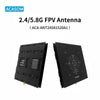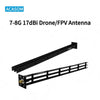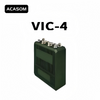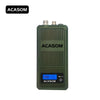ACASOM 1090MHz ADS-B Cavity Filter: Achieving Superior Signal Clarity in RF Systems
Enhancing RF Signal Integrity with Advanced Filter Technology
In today's increasingly crowded radio frequency environment, maintaining signal integrity has become a critical challenge for system operators and engineers. The growing density of wireless devices and transmitters creates interference that can compromise data accuracy and system reliability. The ACASOM 1090MHz ADS-B Cavity Filter represents a sophisticated solution to these challenges, employing advanced filtering technology to ensure optimal signal quality in demanding applications.
This comprehensive guide explores how this precision-engineered component can transform your RF system performance through exceptional signal preservation, industrial-grade construction, and proven reliability in diverse operating environments.
Understanding Cavity Filter Technology
Cavity filters utilize resonant chambers to selectively pass desired frequencies while rejecting unwanted signals. This technology differs fundamentally from simpler filter designs by offering sharper roll-off characteristics and superior out-of-band rejection. The ACASOM 1090MHz Cavity Filter specifically operates within the 1086-1094MHz range, providing an 8MHz bandpass perfectly suited for applications requiring precise frequency control.
The filter's design principles focus on maximizing signal preservation while eliminating interference, making it an indispensable component in systems where data accuracy is paramount. By understanding these operational fundamentals, system designers can better leverage the filter's capabilities in their specific applications.
Key Features and Performance Advantages
Exceptional Signal Preservation
The filter's ultra-low insertion loss of ≤0.5dB represents a significant advancement in signal preservation technology. This minimal loss ensures that desired signals maintain their strength throughout the filtering process, directly impacting system sensitivity and range. In practical terms, this preservation of signal strength can extend effective coverage areas and improve data reliability.
With outstanding out-of-band rejection of ≥75dB at both 1060MHz and 1120MHz, the filter provides exceptional isolation from adjacent frequency interference. This level of rejection ensures that only the intended 1090MHz signals pass through, eliminating noise and interference that could compromise system performance. The steep rejection characteristics create a clear boundary between wanted and unwanted signals, maintaining purity across the entire operating band.
Robust Construction and Reliability
Engineered for durability, the filter features a rugged aluminum housing that provides both mechanical protection and effective heat dissipation. The unit's compact dimensions of 83×55×30mm and 0.4kg weight make it suitable for space-constrained installations while maintaining robust performance characteristics. The black surface finish offers additional protection against environmental factors, ensuring long-term reliability.
The inclusion of N-Type connectors guarantees secure, low-loss connections that maintain signal integrity under various operating conditions. These industry-standard connectors provide excellent mechanical stability and weather resistance, making the filter suitable for both indoor and outdoor installations where environmental factors must be considered.
Optimized Electrical Performance
The exceptional Voltage Standing Wave Ratio (VSWR) of ≤1.2 demonstrates excellent impedance matching that minimizes signal reflections. This parameter is crucial for maintaining transmitter efficiency and preventing potential damage to sensitive RF components. The low VSWR ensures maximum power transfer throughout the system, optimizing overall performance.
With a maximum power handling capability of 20 watts, the filter accommodates high-power applications without performance degradation. The 8MHz bandpass width centered at 1090MHz provides optimal coverage for specific applications while maintaining sharp rejection outside the desired frequency range.
Technical Specifications Overview
| Parameter | Specification |
|---|---|
| Frequency Range | 1086-1094MHz |
| Insertion Loss | ≤0.5dB |
| VSWR | ≤1.2 |
| Maximum Power | 20W |
| Out-of-band Rejection | ≥75dB@100-1060MHz |
| ≥75dB@1120-2700MHz | |
| Connector Type | N-Type |
| Dimensions | 83×55×30mm |
| Weight | 0.4kg |
Application Scenarios
Aviation Monitoring Systems
The filter excels in Automatic Dependent Surveillance-Broadcast (ADS-B) applications, where signal clarity is essential for accurate aircraft tracking and positioning. Aviation monitoring systems benefit from the filter's ability to eliminate interference from adjacent frequencies, ensuring reliable reception of critical positioning data. Ground stations and airport surveillance systems achieve improved performance through enhanced signal-to-noise ratios.
The technology proves particularly valuable in areas with dense RF activity, where multiple communication systems operate simultaneously. The filter's precise frequency selection prevents cross-system interference while maintaining the integrity of aviation data streams.
Industrial IoT Networks
Industrial applications operating in the 1090MHz band benefit significantly from the filter's signal purification capabilities. IoT devices used in monitoring, control, and data collection systems maintain more reliable communications when protected by the cavity filter's interference rejection. Manufacturing facilities and industrial complexes with multiple wireless systems experience improved data integrity through proper filtering implementation.
Remote monitoring applications particularly benefit from the filter's ability to preserve weak signals while rejecting strong interferers. This capability extends the effective range of monitoring systems and reduces data errors in critical industrial processes.
RF Infrastructure Enhancement
Communication infrastructure benefits from the filter's ability to clean receiver inputs in crowded RF environments. Base station applications achieve improved sensitivity through interference reduction, while critical communications systems maintain reliability through enhanced signal purity. The filter's robust construction ensures consistent performance in various environmental conditions.
System integrators can deploy the filter to protect sensitive receiver components from strong out-of-band signals that could cause desensitization or damage. This protection extends equipment lifespan while maintaining optimal system performance.
Installation and Integration Guidelines
Proper installation begins with selecting appropriate coaxial cables that match the system impedance and minimize additional losses. Quality connectors and proper weatherproofing for outdoor installations ensure long-term reliability and consistent performance. The filter's symmetrical design allows flexible installation with either port connected to the antenna or receiver, simplifying integration.
System designers should position the filter as close to the receiver input as practical to maximize performance benefits. Regular inspection of connectors and enclosures maintains optimal operation, particularly in outdoor deployments exposed to environmental elements. Proper grounding and mounting ensure stable performance across temperature variations and mechanical stress conditions.
Comparison: Cavity vs. Alternative Filter Technologies
Cavity filters offer distinct advantages over alternative technologies including ceramic and lumped-element designs. The precision-tuned resonant cavities provide sharper filter cutoffs, resulting in better adjacent channel rejection. Additionally, cavity designs typically exhibit lower insertion loss and higher power handling compared to conventional approaches.
While cavity filters may represent a higher initial investment, the long-term benefits of improved system performance, reduced maintenance, and greater reliability typically yield superior return on investment for commercial applications. The technology's temperature stability and consistent performance over time provide additional value in demanding operating environments.
Frequently Asked Questions
Q: What specific benefits does a cavity filter provide in RF systems?
A: Cavity filters offer superior signal separation through high out-of-band rejection while maintaining minimal insertion loss. This combination preserves desired signals while eliminating interference, directly improving system sensitivity and data accuracy.
Q: How does out-of-band rejection impact real-world system performance?
A: High out-of-band rejection prevents strong interfering signals from overwhelming receivers, ensuring clean signal reception and accurate data decoding. This is particularly important in crowded RF environments where multiple systems operate simultaneously.
Q: Is the filter suitable for continuous outdoor operation?
A: Yes, the rugged aluminum construction and N-Type connectors provide excellent environmental protection. Proper weatherproofing of external connections is recommended for long-term outdoor deployments.
Q: What distinguishes insertion loss from rejection in filter specifications?
A: Insertion loss measures how much the desired signal is weakened when passing through the filter, while rejection indicates how effectively unwanted signals are blocked. Both parameters are crucial for optimal system performance.
Conclusion: Optimizing RF Systems with Precision Filtering
The ACASOM 1090MHz Cavity Filter represents an engineering solution to the growing challenges of RF interference in modern communication systems. By providing exceptional signal preservation, superior interference rejection, and industrial-grade reliability, this component enables system operators to maximize performance while ensuring data integrity.
Whether deploying aviation monitoring systems, industrial IoT networks, or critical communication infrastructure, the integration of high-quality cavity filters delivers tangible benefits in performance, reliability, and operational efficiency. For engineers and system integrators seeking to optimize their RF systems, this filter offers a proven solution backed by robust technical specifications and practical application success.





